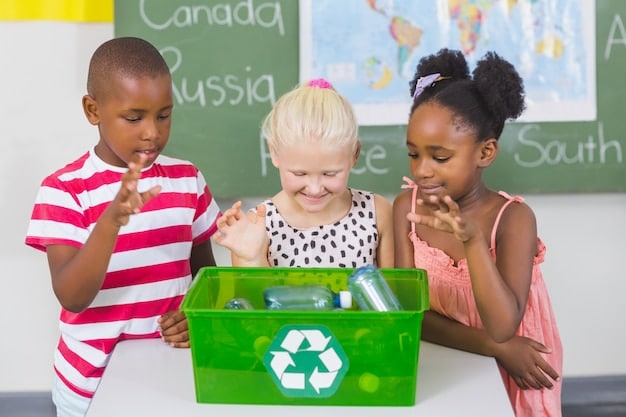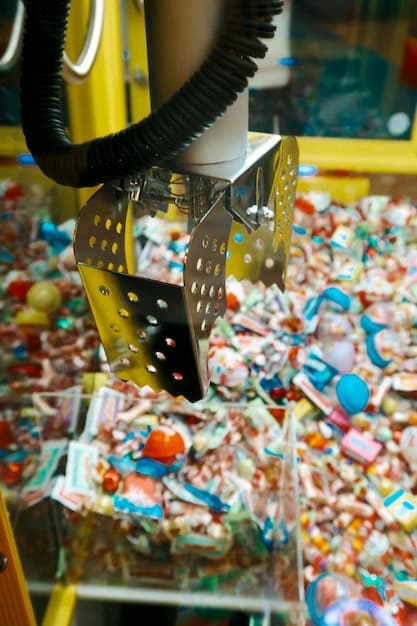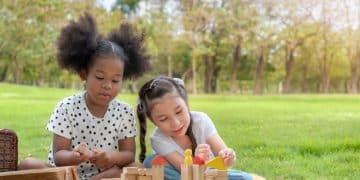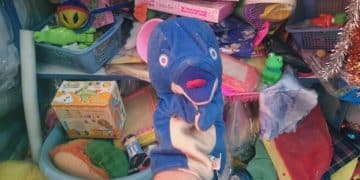Toy Recycling Programs: US Companies Leading the Green Charge

Toy recycling programs in the US are gaining momentum as companies address growing environmental concerns by implementing initiatives to repurpose materials, reduce waste, and promote sustainable practices within the toy industry.
The toy industry, often associated with joy and play, is increasingly under scrutiny for its environmental impact. Recognizing the need for change, several **toy recycling programs: How US Companies are Addressing Environmental Concerns** are stepping up to address these challenges and embrace sustainable practices.
Understanding the Environmental Impact of Toys
Toys bring joy to millions of children, but their production and disposal can have significant environmental consequences. From the extraction of raw materials to the energy-intensive manufacturing processes and the eventual landfill burden, it’s crucial to understand these impacts.
The lifecycle of a toy: Environmental footprint
The environmental footprint of a toy encompasses every stage of its life, from design and manufacturing to usage and disposal. Each phase presents unique challenges and opportunities for improvement.
- Raw materials extraction: Many toys rely on plastics, metals, and other materials sourced through mining and drilling, which can lead to habitat destruction and pollution.
- Manufacturing processes: Energy-intensive processes contribute to greenhouse gas emissions and can generate hazardous waste.
- Transportation: Shipping toys from factories to retailers worldwide adds to carbon emissions.
- Disposal: Most toys end up in landfills, where they can take hundreds of years to decompose, leaking harmful chemicals into the environment.
Understanding these environmental impacts is the first step toward creating more eco-friendly toys and implementing effective recycling programs. By minimizing waste and maximizing resource efficiency, the toy industry can reduce its carbon footprint and protect the planet for future generations.
The Rise of Toy Recycling Programs in the US
In response to growing environmental concerns, several toy recycling programs have emerged across the US. These initiatives aim to divert toys from landfills and repurpose their materials in a sustainable manner.

Innovative approaches to toy recycling
Toy recycling involves a range of innovative approaches to ensure that valuable materials are recovered and reused, minimizing waste and reducing the need for virgin resources.
One common method is mechanical recycling, where toys are shredded, sorted by plastic type, and then melted down to create new products. This process reduces the demand for new plastic production and lowers greenhouse gas emissions.
Chemical recycling is another option, although less common, that breaks down plastic polymers into their original building blocks, which can then be used to create virgin-quality plastic. This method is useful for dealing with mixed or contaminated plastic waste that is difficult to recycle mechanically.
In addition to these technical processes, some companies are exploring design for recyclability, creating toys that are easier to disassemble and recycle at the end of their life. This involves reducing the number of different materials used and avoiding the use of glues and other adhesives that can complicate the recycling process.
By investing in research and development and collaborating with recycling facilities, toy manufacturers can further refine these innovative approaches and increase the efficiency and effectiveness of toy recycling programs.
Leading US Companies in Toy Recycling
Several US companies are taking proactive steps to address the environmental impact of toys by establishing and participating in toy recycling programs: How US Companies are Addressing Environmental Concerns. These companies are not only reducing waste but also inspiring others to adopt more sustainable practices.
Hasbro’s toy recycling initiative: A case study
Hasbro, one of the world’s leading toy and game companies, has launched a toy recycling program called “Hasbro Toy Recycling” to give new life to well-loved toys and games. Through this program, parents can send their children’s used toys and games to TerraCycle, a recycling company that specializes in hard-to-recycle materials. TerraCycle then sorts and processes these items, turning them into raw materials that can be used to create new products.
The Hasbro Toy Recycling program accepts a wide variety of toys and games, including board games, action figures, dolls, and electronic toys. However, it does not accept items that contain batteries, as these need to be removed and recycled separately.
To participate in the program, individuals can visit the TerraCycle website to sign up and download a free shipping label. They can then pack their used toys and games into a box, affix the shipping label, and send it to TerraCycle for recycling. This simple and convenient process makes it easy for parents to responsibly dispose of their children’s old toys and games.
By implementing its toy recycling program, Hasbro is demonstrating its commitment to environmental sustainability and helping to create a more circular economy for toys. This initiative not only reduces waste but also educates consumers about the importance of recycling and responsible consumption.
Hasbro’s toy recycling initiative demonstrates a commitment to environmental sustainability, offering consumers an easy way to recycle toys and reduce landfill waste.
Challenges and Opportunities in Toy Recycling
While some initiatives are effective, toy recycling faces several challenges. Addressing these challenges is essential for expanding the reach and impact of recycling programs. However, with these challenges come opportunities for further innovation and collaboration.

Material composition and recyclability
One of the primary challenges in toy recycling is the complex material composition of many toys. Toys often consist of multiple materials, including different types of plastics, metals, fabrics, and electronics, making it difficult to separate and recycle them effectively.
- Mixed materials: Toys containing a combination of plastics, metals, and fabrics require specialized sorting and processing techniques, which not all recycling facilities are equipped to handle.
- Hazardous materials: Electronic toys may contain hazardous materials, such as batteries and heavy metals, which need to be removed and disposed of separately to prevent environmental contamination.
- Lack of standardization: The lack of standardization in toy design and materials further complicates the recycling process, as recycling facilities need to develop specific procedures for handling different types of toys.
Despite these challenges, there are opportunities to improve the recyclability of toys by promoting design for recyclability and investing in advanced recycling technologies. By working together, toy manufacturers, recyclers, and policymakers can overcome these obstacles and create a more sustainable future for the toy industry.
Addressing these challenges requires collaboration among manufacturers, recyclers, and consumers to promote sustainable toy design and enhance recycling infrastructure.
Consumer Engagement and Education
The success of toy recycling programs relies heavily on consumer participation and awareness. Educating consumers about the benefits of toy recycling and providing convenient ways to participate is crucial for maximizing the impact of these initiatives.
Raising awareness among parents and children
Effective consumer engagement involves reaching both parents and children with educational messages about toy recycling. By raising awareness and promoting responsible consumption habits, we can inspire a new generation of eco-conscious consumers.
To engage parents, toy companies and recycling organizations can use various channels, such as social media, websites, and parenting blogs, to share information about toy recycling programs and their environmental benefits. They can also offer tips on how to properly sort and prepare toys for recycling, as well as provide resources for finding local recycling facilities.
Engaging children in toy recycling efforts is equally important. By educating children about the importance of reducing waste and conserving resources, we can instill in them a lifelong commitment to environmental sustainability. This can be achieved through educational toys, games, and activities that teach children about recycling and its positive impact on the planet.
In addition to raising awareness, providing convenient ways for consumers to participate in toy recycling programs is essential. For example, toy companies can partner with retailers to establish in-store collection points where consumers can drop off their used toys for recycling. They can also offer mail-in recycling programs, where consumers can send their toys to a recycling facility using a prepaid shipping label.
By making toy recycling easy and accessible, we can encourage more consumers to participate and divert more toys from landfills. This not only benefits the environment but also helps to create a more sustainable and circular economy for the toy industry.
Educating consumers about the importance of toy recycling and making it easy for them to participate are essential steps in creating a more sustainable toy industry.
The Future of Sustainable Toys
The future of the toy industry lies in embracing sustainability and creating products that are both fun and environmentally responsible. By prioritizing sustainable design, materials, and recycling practices, the industry can minimize its impact on the planet and contribute to a more circular economy.
Innovations in sustainable toy materials
One of the most promising areas of innovation for sustainable toys is the development of new and eco-friendly materials. These materials not only reduce the environmental impact of toy production but also offer unique properties and design possibilities.
- Bio-plastics: Made from renewable resources, such as corn starch or sugarcane, bio-plastics are biodegradable and compostable, making them a sustainable alternative to traditional petroleum-based plastics.
- Recycled plastics: Using recycled plastics in toy production reduces the demand for virgin plastic and helps to divert waste from landfills.
- Sustainable wood: Sourced from sustainably managed forests, sustainable wood provides a renewable and biodegradable material for toy construction.
In addition to these materials, toy companies are also exploring innovative design approaches that prioritize durability, repairability, and recyclability. By designing toys that are built to last and easy to disassemble and recycle, the industry can reduce waste and promote a more circular economy.
| Key Point | Brief Description |
|---|---|
| ♻️ Environmental Impact | Toys contribute to landfill waste and resource depletion. |
| 🌱 Toy Recycling Programs | Initiatives aim to repurpose toys, reducing waste and promoting sustainability. |
| 🧩 Leading Companies | Hasbro and others are implementing recycling and material innovations. |
| 👨👩👧👦 Consumer Engagement | Education and easy participation are vital for program success. |
FAQ
▼
Most plastic toys, board games, and action figures are recyclable. However, items with batteries or electronic components require special handling.
▼
Check with local waste management services or search online for toy recycling programs in your area. Some companies also offer mail-in programs.
▼
Recycled toys are typically broken down into raw materials, which can then be used to manufacture new products, reducing the need for virgin resources.
▼
Toy recycling reduces landfill waste, conserves resources, and minimizes the environmental impact of toy production and disposal.
▼
Design for recyclability involves creating toys that are easy to disassemble and recycle, using fewer mixed materials and avoiding hazardous components.
Conclusion
As the US grapples with increasing environmental concerns, the efforts of companies to implement toy recycling programs represent a crucial step towards sustainability. By addressing the challenges and seizing the opportunities in toy recycling, the industry can minimize its ecological footprint, promote responsible consumption, and contribute to a greener future for generations to come.





